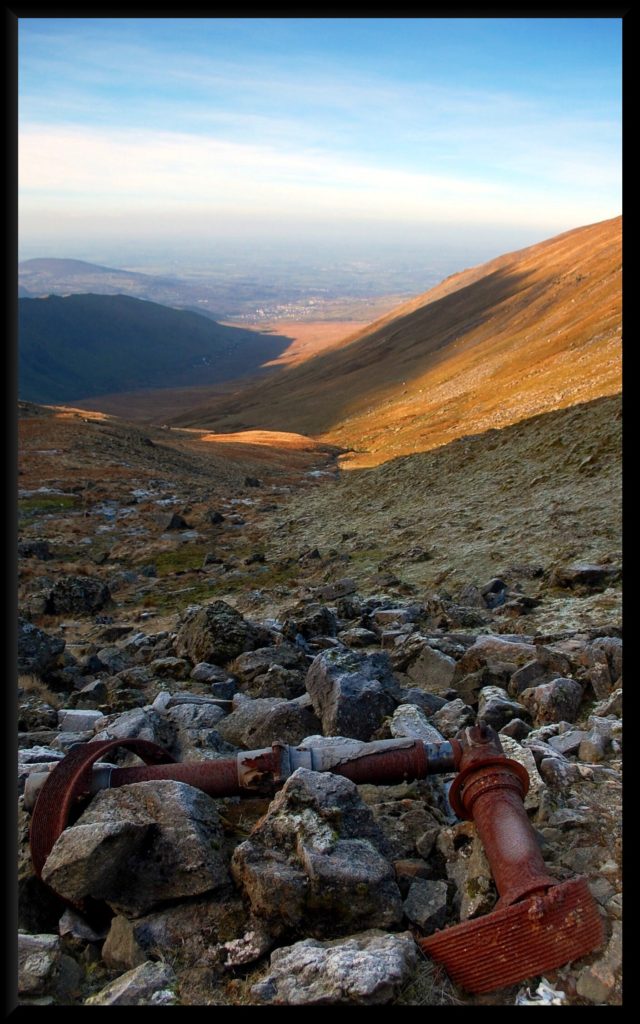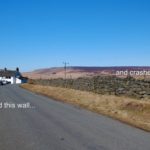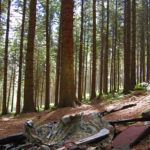Avro Lincoln RF511
‹ Return to Air Crash Sites

Avro Lincoln RF511
The Avro Lincoln was the successor to the Lancaster bomber.
On March 15 1950, three Lincolns were completing a night navigation exercise out of RAF Scampton in Lincolnshire, but due to poor weather were unable to return to base and so were diverted to RAF Valley on Anglesey (which is where Prince William is currently posted).
While the other two Lincolns landed safely, a communication error meant RF511’s radio operator took an incorrect bearing, resulting in the bomber flying into the southern slopes of Carnedd Llewelyn, 20 miles south east of RAF Valley, with the loss of all on board.
The photo above was taken from the impact point, and wreckage is strewn all down the valley.
Crew
Squadron Leader John Talbot Lovell Shore MC, AFC (Pilot)
Flight Lieutenant Cyril Alfred Lindsey (Navigator)
Engineer Ronald Albert Forsdyke DFC (Flight Engineer)
Signaller Harold Henry Charman (Radio Operator)
Gunner Godfrey Leo Cundy (Air Gunner)
Gunner Robert Henry Wood (Air Gunner)
Part of a wing in Afon Llafar

Avro Lincoln Lincoln II RF398

ESCAPE FROM STALAG LUFT I
The pilot of RF511, Squadron Leader John Shore, had been awarded the Military Cross on March 13th 1942 for escaping from Stalag Luft I and returning to the UK.
He had been the pilot of a 9 Squadron Wellington bomber, R1335, which was shot down over Holland by a Luftwaffe nightfighter while returning from a raid on Germany, March 27 1941. All on board managed to escape the doomed Wellington and Shore and his crew were taken prisoner. He escaped seven months later by digging a tunnel under the fence of the camp and making his way to neutral Sweden.
Page 29 of this RAF publication “Spirit of the Air” (2007) has an account by Sqn Ldr Shore’s son, Wing Commander Ian Shore, who retraced his father’s steps from the POW camp.
33 comments on “Avro Lincoln RF511”
Leave a Reply Cancel reply
Image Information
-
Full Size: 1408×2254px
Aperture: f/5.6
Focal Length: 18mm
ISO: 200
Shutter: 1/160 sec
Camera: NIKON D40



I wonder how long this plane was in service, it must have been dated by the new jets by then.
Brilliant composition and great light. Exceptional info as ever..
[http://www.flickr.com/photos/31878512@N06] [http://www.flickr.com/photos/nondesigner]
Cheeers both.
It was the last of the piston engined bombers, came too late to see action in WW2,
Hi Ian
I am writing an article about navigation and compass work for a UK magazine called Outdoor Fitness. It weaves in stories from the 1st and 2nd World War about other POWs such as Franz Von Werra (The One That Got Away) and a tale of my great-grandfather and his improvised compass made in a WW1 POW camp.
The photos are wonderful in this article and I was wondering if I could present them to the editor to accompany the story?
Kind regards
Matt Maynard
By all means. A credit to aircrashsites.co.uk would be appreciated.
If you need them, I have some other photos from this crash site.
Ian
Well researched as always.
wow shot Ian. love how you’ve black bordered it – really ties it together nicely. gorgeous light throughout, love the sunny warmth of the hills against the cooler feeling crash site, which to my mind adds a narrative to the shot. great deep view down that valley showing the treacherous altitude / nature of the terrain.
wonderfully worded and researched, will take a check of the link on retracing the steps. might need to get my hankie first but. sux that this was brought about by poor communication. really sux.
This works really well Ian …you said you had a good shot here.
The waterfall too is a cracker ,far better than mine .
and that is a great story , thanks for the link.
[http://www.flickr.com/photos/31878512@N06]
They were in service with the RAF until march 1963 almost 49 years ago. Argentina still had some in service in 1967.
They were not used as bombers by then , training aircraft and a whole host of other tasks took over from offensive purposes.
Above all else Ian, its a fabulous image with great dof, clarity and colours! Along with that are your investagitive insights which are always interesting and by their very nature somewhat tragic too!
There is one Lincoln at RAFCosford – incredible that out of 604 built – RF398 there is the sole remaining intact survivor!
p.s .. the link came up as pg 31 on mine. if that matters. pls delete this
This is awesome Ian, wonderful photos but such a sad story beautifully narrated and researched!!!
Oh wow indeed! Great pics, very informative. You stream always has something interesting to read and learn about
🙂
That long sweeping shot of the valley is a stunner Ian. Absolute belter mate.
Excellent, well-presented images and great back story
Nice work Ian. Did you see the memorial plaque at the crash site?
Sad story again Ian, brilliantly researched. Superb view, but I’m particularly taken with the shot of the wing. How big a bit of wing is that? Looks large, but I’m guessing the icicles were not huge. I always like the blurry, milky water shots….
Great Ian she not as good looking as the Lancaster .
But still a beauty.
Great work again Ian
Great use of the landscape in this Ian, some great contrasting light going on
Great view point Ian – interesting that this debris is still in the same spot. i would guess some forces of nature would flow down here from time to time
Love that splash of light in the photo.
brilliant photo ian ,great view
Many thanks everyone. Will catch up soon!
[http://www.flickr.com/photos/angwickham]
Cheers Ang. It is a very sad site. Really was easy to picture the violence of the crash because of the shattered and smashed debris all around the jagged rocks and along the stream.
re; the page numbering, yeah the pdf has it at page 31, but it’s page 29 of the original publication.
[http://www.flickr.com/photos/29288836@N00]
Thanks Rob. Only one left in the UK, aye. Shame I never got to Cosford first to photograph it myself.
[http://www.flickr.com/photos/gastephen] .
Cheers Graham, saw one plaque, not the other. Knew it was around somewhere, but we needed to press on!
[http://www.flickr.com/photos/amybigkiss]
Thanks Amy. It is a particularly large piece of debris. This is it viewed from the other end.
Another great collection of photographic excellence here Ian, keep up the good work!
What a great tribute, as if the first picture is their monument.
[http://www.flickr.com/photos/vercettisworld]
I sometimes think that about these places, the wreckage becomes the crews monument.
Hello Ian, I am writing a piece about this accident for the annual report of the local mountain rescue team. It forms part of a larger project looking at various accidents in the hills. Would it be possible to use your excellent photograph of the crash site in the article please?
Many thanks
Hi Hazel yes feel free, a credit to aircrashsites.co.uk would be appreciated.
Thank you for asking
Ian
Thank you very much Ian. Do you also happen to know if the memorial plaque is near the cairn marking the point of impact? I haven’t managed to get up to the site yet so if you have a rough idea that would be very helpful.
Thanks once again
Hazel
Yes the memorial plaque is at grid reference SH 67992 63776 (source; peakwreckhunters) apparently sited at the impact point.
Thanks very much Ian – this is really helpful. I will certainly acknowledge your photograph and the help you have given me in the article.
Best wishes
Hazel
Thanks Hazel, good luck with your article.
Ian